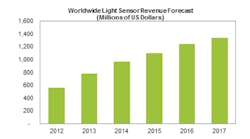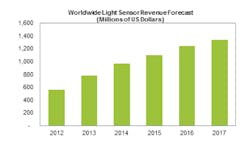Market researcher IHS pegs light and proximity sensor revenue at more than $780 million this year, up 41% from more than $555 million in 2012, according to a new report from the researcher’s MEMS and Sensors Service. The trend is being driven largely by demand for such sensors in smart phones and tablets, where they are applied to detect a user’s presence as well as optimize display brightness and color rending.
IHS says electronics giants Apple and Samsung are leading the way with new applications designed to stay ahead of the technology curve.
“The continued growth of the smart phone and tablet markets serve as the foundation of a bright future for light sensors,” said Marwan Boustany, senior analyst for MEMS and sensors at IHS. “Market leaders in these areas are driving the growth, with Apple pioneering their adoption and Samsung later taking the lead in their usage.”
Following the predicted 41% growth this year, the light and proximity sensor market is expected to maintain double-digit growth through 2016 before moderating to around 8% growth in 2017 to $1.3 billion globally.
The IHS report points to three types of light and proximity sensors: ambient light sensors (ALS) that measure the intensity of the surrounding light enveloping a cellphone or tablet to adjust screen brightness and save battery power; RGB sensors that measure a room’s color temperature via the red, green and blue wavelengths of light to help correct white balance in the device display; and proximity sensors that disable a handset’s touch screen when it is held close to the head in order to avoid unwanted input and also to turn off the light in the display to save battery power.
Much of the market growth is due to a shift in designers’ use of ALS to RGB in mid- to high-end smart phones, the growing application of proximity sensors with gesture capabilities as opposed to simple proximity sensors, and the associated price premiums that accompany those changes, the report says.
Source: IHS, Inc.









